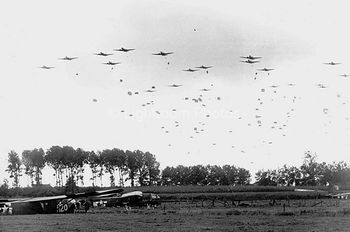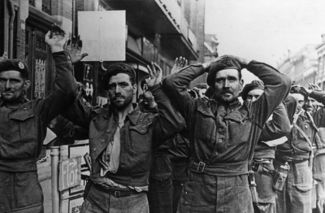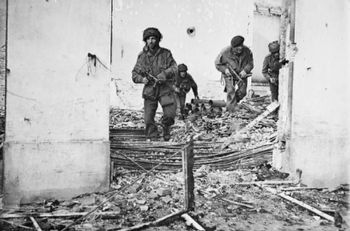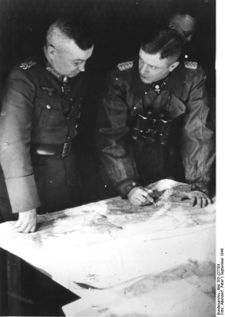Why did Operation Market Garden in 1944 fail
<youtube>https://www.youtube.com/watch?v=8xwrIy1JzL0<youtube>
Operation Market Garden, launched in September 1944, was an unsuccessful Allied offensive mainly fought in the Netherlands. It was the largest airborne operation in history up to that time. The operation was a daring one, and it was the brainchild of the British General Bernard Montgomery. This operation was even the subject of the 1977 star-studded movie A Bridge Too Far directed by Richard Attenborough. He intended the airborne offensive to allow the allies to break into the German heartland and to end the war quickly. However, this was not the case. The allied offensive was to prove to be a costly failure and may have even delayed their victory in Europe. Why did this operation fail? Was it Montgomery's over-optimistic planning, poor strategy, poor leadership, German resistance, or the terrain?
Background
The Allies had landed in Normandy on the 6th of June 1944. After establishing several beachheads in Normandy, the Allies managed to push forward into the Normandy countryside.[1] The Germans initially managed to slow the Allies advance. However, a brilliant piece of Allied strategy resulted in the encirclement of a large part of the German army in the Falaise Pocket. The combined Anglo-American divisions inflicted huge losses on the Germans. The German army was forced into a headlong retreat. Paris was soon retaken by the Allies.[2] The German army was practically forced out of France and retreated towards Alsace-Lorraine and Belgium. It seemed to many that the Allies were on the verge of invading German, and some even spoke optimistically of ending the war by Christmas.
However, in truth, the Allied successes had brought its own problems. The Allies' supply lines were overstretched, slowing down the Americans and British in particular. The shortage of oil meant that Patton’s armored divisions had to halt their advance. This was to prove crucial, and it allowed the Germans to regroup in the west when it appeared that they would disintegrate, leading to the end of the war.[3]
Reasons for Market Garden
By the Autumn of 1944, it was apparent to the Allied High Command that the Germans had managed to retrieve the situation and would offer stiff resistance to any future offensive. In August 1944, a British assault failed to take Antwerp's deep water port and had allowed some 80,000 German troops from Scheldt Estuary. This became known as the ‘Great Mistake’ and was perhaps one of the biggest in the entire war.[4] The Allied high command was reluctant to attack the Germans from eastern France, as the German government had constructed a massive line of defenses, consisting of fortresses, to protect their western border. This was known as the Siegfried Line. The British and the Americans had to go through the Low Countries to invade Germany and end the war.[5]
The Allies believed that they would need an innovative plan to break the Low Countries and Alsace-Lorraine's German frontline. General Eisenhower and other leaders turned their attention to the Low Countries. It offered them ports that could be used to re-supply the Allied divisions, who still were reliant on the Normandy ports for their supplies. The more forward-thinking of the allied strategists became concerned about the Rhine.[6] This river would form a formidable natural barrier to any Allied advance, but if they liberated the Low Countries, it would allow them to cross the Rhine and then to cross into Northern Germany and then onto Berlin. The American and British governments became increasingly eager to end the War in Europe and wanted to turn their attention to the Pacific War. Then the western allies believed that they were in a race to Berlin with the Soviet Army, and they did not want the Red Army to capture all Germany and turn it into a client state of Moscow.
Montgomery's Strategy
The allies needed to break the Germans' resistance and cross the Rhine in the Low Countries. General Bernard Montgomery, the hero of the British victory at El Alamein, proposed a daring plan. As recounted in his memoirs, field Marshal Montgomery’s goal was to invade Germany by securing the bridges over the Lower Rhine in the Netherlands.[7] This idea had several advantages such as by-passing the Siegfried Line. Montgomery wanted an airborne assault in the Netherlands to secure key bridges over the Lower Rhine. This would allow the Allies to enter into the Northern German plains, where there were no natural barriers, to their advance to Berlin.[8]
Montgomery’s plan was initially more ambitious, but he scaled back his plans according to Eisenhower’s criticism. Montgomery proposed the following; airborne units would be dropped behind the German lines to secure the bridges over the Meuse and the two tributaries of the Rhine. The airborne units would hold the bridges until the British ground forces arrived. Montgomery believed that not only would this airborne operation succeed in securing bridges over the Rhine but result in the retreat of German Divisions into Germany. The Allied High Command agreed to the plan. Montgomery staked his reputation on the strategy and was backed by Churchill. The offensive was to be called Market Garden. The 'Market' part of the operation involved the airborne aspect of the operation.[9]
The operation would involve four airborne divisions. The paratroopers would land in the area by gliders, or they would parachute into the target zones. Some 50,000 troops were involved, and they would also be supplied with some light artillery. There were American, British, and Polish units involved in the massive airdrops. The ‘Garden’ part of the plan would involve several British Armored Divisions moving into the Netherlands to link up with the paratroopers and defend the bridges from any German counterattack. According to Montgomery, for the strategy to have worked, it depended on two things, the quick capture of all the bridges by the Allies and the ground forces linking with the paratroopers within days.[10]
The Battle
Operation Market Garden began on the 17th of September 1944. It was a coordinated action by American, British a Polish Airborne, and mainly British forces. The operation began with heavy air raids to weaken any resistance. The paratroopers began landing at 13.00hrs around targets in the Netherlands, chiefly Eindhoven, Arnhem, and Nijmegen.[11]. The paratroopers had the advantage of surprise, and they achieved their objectives. The Germans had been taken completely by surprise. The initial phase of the operation was a total success. It had been feared that the Germans would blow up the bridges, which would mean that the plan would have to be aborted. The rapid capture of the bridges meant that the ground forces would be able to reach the landing zones and support the paratroopers.[12]

The British ground forces fought their way to Nijmegen and captured the city, after some fierce fighting. The British Ground forces captured one after another the bridges. The operation appeared to be going to plan despite heavier than anticipated German resistance. The most important bridge was Arnhem. This was the most strategically significant bridge. It had to be seized by the ground forces if Market Garden was to succeed in its objectives. The British paratroopers had captured the bridge, but they soon came under fierce attack from the crack 9th and 10th SS Panzer Divisions.[13] The SS had armor and tanks, and they pounded the British paratroopers mercilessly.
The British paratroopers soon found themselves surrounded as the SS had encircled them. The lightly armed British soldiers fought bravely, but they could not hold out for long. An elite British unit, the Irish Guards, was fighting its way forward to help the airborne troops. However, because of the terrain, they had to fight their way up to Arnhem on a single road, and they were constantly attacked. This road came to be known as the Highway to Hell. The Guards' tanks could not leave the narrow road as the ground was very marshy and much of it was bogland. As the Irish Guards made their way to Arnhem, they were easily picked off by the Germans, who attacked them from the woodland cover. Eventually, such was the ferocity of the German resistance that the British came to a halt. The paratroopers at Arnhem were isolated and cut-off and were forced to surrender. Operation Market Garden had achieved all of its objectives, except the most important one, the capture of the Bridge at Arnhem.[14]
Montgomery’s Optimistic Planning
Even before the start of the operation, many feared that Montgomery’s plan was too optimistic. The Polish airborne unit commander declared that the plan was flawed and famously stated that the prime objective of the offensive the Arnhem Bridge was ‘a bridge too far.’[15] He meant that Montgomery’s aims were simply too ambitious and that he was asking too much of his men. Montgomery also assumed that the paratroop unit could retain their landing zones and the bridges for a given period of time. Paratroops were only lightly armed, and without support from ground troops and tanks, they could not hold out for long. The British General was wrong to believe that airborne troops could resist assault from ground troops supported by armor for several days.
Crucially Montgomery failed to understand the terrain that he expected his men to fight in. The roads in the Netherlands were narrow, and that the ground around them was unsuitable for armor. This was a fundamental error- Montgomery had simply assumed that his tanks could rapidly make their way to the landing zones by using only the roads. During the battle, the roads became death traps for many British units. They soon became clogged with burned-out tanks and vehicles. This critically delayed the ground forces coming to the support of the paratroopers in Arnhem in particular. Perhaps the Montgomery plan's biggest failing was that it assumed that the Germans had been decisively beaten and that any counter-attack that they could launch in the area would be limited.[16]
German Counter-attack
The Germans had been driven back some two hundred miles in a matter of weeks. The British and the Americans dominated the skies and constantly harassed the Germans. The roads had become very unsafe for the Germans, and they had also come under attack from the local resistance movements. The Germans had lost some 90,000 killed or wounded during the summer of 1944, and a further 200,000 had been taken prisoner or missing in action.[17] However, after the British army failed to encircle the German army in the Scheldt Estuary, it allowed the Germans time to regroup in the Netherlands. The German front had begun to stabilize. They were also ably led by the very experienced General Walter Model. He also received some reinforcements in the remaining units of the 9th and 10th SS Panzer Divisions. Unfortunately, for the Allies, especially the British, the SS units were positioned in Arnhem. This was not merely bad luck, but due to good German intelligence.[18]Intelligence Failure
The Germans had anticipated that there would be an offensive launched to seize Arnhem, Wesel, and Nijmegen. A senior intelligence official argued that the British and the Americans would use airborne troops. However, he did not predict where the assault would be. Nevertheless, German intelligence provided the High Command with the information they needed to prepare for any planned Allied attack. The German General Model heeded his intelligence officers, and this was to prove decisive. The British had excellent intelligence.[19] They had reliable information on the Germans' movements from the Dutch Resistance, and they could also employ aerial reconnaissance planes to obtain photographic intelligence. One reconnaissance mission was able to provide images that seemed to show German forces in the Arnhem area. This was confirmed by information from the local resistance. This was compelling proof that the Germans had significant forces and that any air assault on the region would be a great risk.
The intelligence officer who reported this to Montgomery was not believed. When he tried to persuade Montgomery that there was a large build-up of German forces near Arnhem, he was relieved of his command, and rumors spread that he had a nervous breakdown. Montgomery’s refusal to heed intelligence was to result in a near disaster for the British. It appears that the General refused to countenance anything that contradicted his views as he was utterly convinced of the brilliance of his plans for Market Garden and his own infallibility.[20]
Consequences of Market Garden
Related DailyHistory.org Articles
- How did Mussolini Rise to Power as the Dictator of Italy
- Why did Germany lose the Battle of Stalingrad
- What were Joseph Stalin's goals as World War Two ended
- How did World War II Lead to the Cold War
- How historically accurate is the movie Hurricane (aka Mission of Honor)
- Why did Japan attack Pearl Harbor in 1941
- Why did the Mukden Incident lead to the creation of the Stimson Doctrine in 1932 by the United States
The operation was not a total failure as it led to the liberation of large southern Netherlands areas and gained hold of several strategic bridges. However, it failed to secure the key bridge at Arnhem, which would have allowed the Allies to cross the Rhine. The failure at Arnhem meant that any planned invasion of Germany had to be delayed. The Germans, although they had lost ground, we're able to establish a strong defensive line. In total, the Allies had suffered some 15,000 casualties and had many thousands more taken prisoner. The Germans had also lost equipment and vehicles that they could ill-afford to use. An unintended consequence of the offensive was a serious famine in the Netherlands. The Dutch railways stopped during the battle to stop German reinforcements from getting to the front line. In revenge, the Germans forbade the transportation of food, by train and in the following winter, there were serious food shortages throughout the Netherland’s and thousands died of starvation or malnutrition.[21]
Conclusion
Operation Market Garden was a tactical defeat for the Allies, as it failed to achieve all its objectives. It failed to secure the key bridge at Arnhem, which meant that they were halted at the Rhine. This probably delayed the eventual Allied victory in western Europe. The operation failed because of a failure in planning, intelligence, and a lack of understanding of the terrain's nature. There was also a mistaken belief that the Germans had been all but defeated. Moreover, Market Garden was fundamentally flawed as it mistakenly believed that airborne forces could resist heavily armed troops for an extended period. While not exclusively to blame, many of these failures resulted from Montgomery and his over-optimistic ideas and arrogance. The failure of Operation Market Garden was largely the result of General Montgomery's poor leadership and tactics.
References
- ↑ Harclerode, Peter, Wings Of War: Airborne Warfare 1918–1945 (Weidenfeld & Nicolson, London, 2005), p. 45
- ↑ Harcerode, p. 46
- ↑ Burgett, Donald. The Road to Arnhem: A Screaming Eagle in Holland. (Dell Publishing, NY, 2001), p. 9
- ↑ Burgett, p. 37
- ↑ Ryan, Cornelius, A Bridge Too Far (Wordsworth Editions, London, 1999), p. 78
- ↑ Ryan, p. 46
- ↑ Montgomery, Bernard Law. Normandy to the Baltic (Hutchinson & Co. London, 1947), p. 157
- ↑ Burgett, p. 117
- ↑ Montgomery, p. 113
- ↑ Montgomery, p. 118
- ↑ Devlin, Gerard M.. Paratrooper: The Saga Of Parachute And Glider Combat Troops During World War II Robson Books, NY, 1979), p. 117
- ↑ Devlin, p. 119
- ↑ Hastings, Max, Armageddon: The Battle for Germany 1944–45 (London: Pan Books, 2004), p.123
- ↑ Hastings, p. 135
- ↑ Ryan, p 89
- ↑ Montgomery, p. 178
- ↑ Ryan, p. 1, 45
- ↑ Hastings, p. 119
- ↑ Ryan, p. 45
- ↑ Harclerode, p. 127
- ↑ Ryan, p. 378
Admin, Ewhelan and EricLambrecht Updated November 21, 2020





